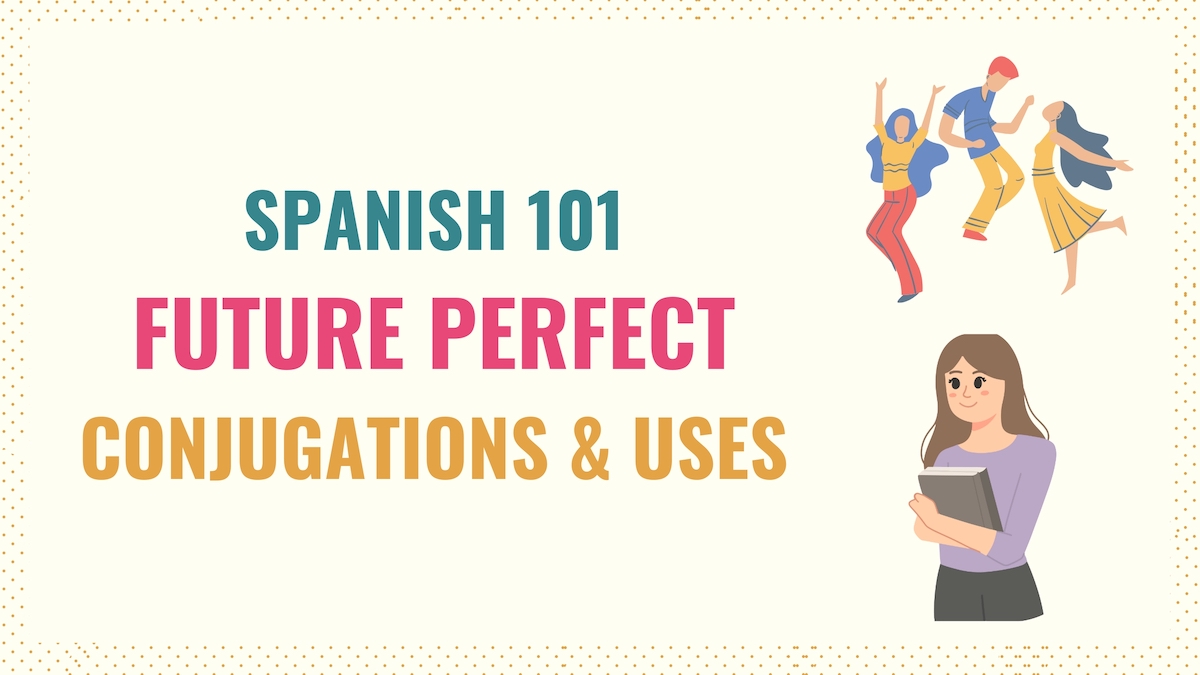Although it also refers to future actions, the future perfect Spanish tense is reserved for specific contexts. If you want to take your Spanish to the next level, understanding the future perfect tense is necessary. So, in this guide, we’ll go over:
I’ve included real-life examples to see how to apply this Spanish future tense correctly.
How to Conjugate Verbs to the Future Perfect Tense in Spanish
The future perfect in Spanish is a compound tense. To form it, you must use the future forms of the auxiliary verb haber and a verb in past participle form (main verb).
Here are the conjugations of haber in the future tense:
- Yo habré: I will have
- Tú habrás: You will have
- Él / Ella / Usted habrá: He / She / You will have
- Nosotros habremos: We will have
- Vosotros habréis: You will have (Castilian Spanish)
- Ellos / Ellas / Ustedes habrán: They / You will have
Take Note: The Spanish verb ‘haber’ is conjugated in the future indicative tense. There is also a future perfect subjunctive. However, the subjunctive future perfect is not used in modern Spanish. This guide only focuses on the indicative mood.
On the other hand, Spanish past participle verbs are formed by adding the endings -ado (AR verbs) and -edo (ER & IR verbs) to the verb root. Be aware that some irregular past participles don’t follow this standard pattern.
Here are some sentences using the future perfect in Spanish:
[Future forms of haber] + [past participle verb]
¿Quién se habrá comido mi pastel?
Who might have eaten my cake?
¿Crees que ya habrán abierto la tienda?
Do you think they may have already opened the store yet?
En un mes, habré terminado de leer este libro.
In a month, I will have finished reading this book.
Example #1 uses the pronominal verb comerse. With these verbs, you must place the object pronoun before haber. This rule also applies to direct and indirect objects.
Para el próximo año, le habremos comprado un carro a Luz.
By next year, we will have bought Luz a car.
Take Note: In compound tenses, Spanish auxiliary verbs inform the time (the future, in this case) when an action takes place and who performs it.

When & How to Use the Spanish Future Perfect
Now that you know how to form the future perfect tense in Spanish, let’s check some of its most common applications.
In Spanish, the future perfect has two main uses:
1. Inform that an action will happen before a specific time or event in the future
When using this application, you must specify a reference point (time or event). This allows you to convey that the future activity will be over before reaching that time frame. For example:
[Reference point] + [future perfect]
En dos horas, habremos llegado.
We will have arrived in two hours.
Para cuando llegues, la comida se habrá acabado.
When you arrive, the food will be gone.
A los cinco años, Janice habrá aprendido otro idioma.
When she’s five, Janice will have learned another language.

Take Note: In Spanish, a reference point can be placed at the beginning or end of a sentence.
2. Express conjectures and probabilities about a past action
The Spanish future perfect tense is also used to speculate about an activity that occurred in the past. Simply put, this use refers to things that may have happened.
¿Quién habrá olvidado este celular?
Who might have forgotten this phone?
Lucy no está, seguro habrá salido a correr.
Lucy is not here; she must have gone for a run.
¿Crees que los chicos habrán cerrado las ventanas?
Do you think the boys have closed the windows?
Let’s take example #1 to understand this use. When asking this question, the phone’s owner already forgot his or her cell in this place. Although implicit, this is the past action I’m speculating about.
Bonus: Future Perfect vs Conditional Perfect
Because they’re both formed with haber + past participle, the future and conditional perfect tenses can be easily confused. However, there is a significant difference between them.
As mentioned above, the future perfect in Spanish expresses that an action will happen before a future reference point or to make conjectures about a past event.
On the other hand, the Spanish conditional perfect tense conveys that an action would have happened if a condition had been met.

Future Perfect Spanish Extra Resources
To master the future perfect in Spanish, you should learn how to conjugate the verb haber and the rules to form past participles. These resources are essential to forming compound tenses in Spanish.
Depending on what you need to express, there are different ways to form the future in Spanish. In this guide, we studied the future perfect tense, but you should also check:
If you’re interested in leveling up your Spanish, you should also learn the most common tenses we use in this language.
Download the Future Perfect Cheat Sheets PDF
Since they’re made of multiple conjugated verbs and their uses seem more advanced, perfect tenses such as the Spanish future perfect can be challenging for beginners to learn and start using in their conversations. I’ve put together a PDF with the graphics and examples from this guide to review the future perfect whenever you’d like.





